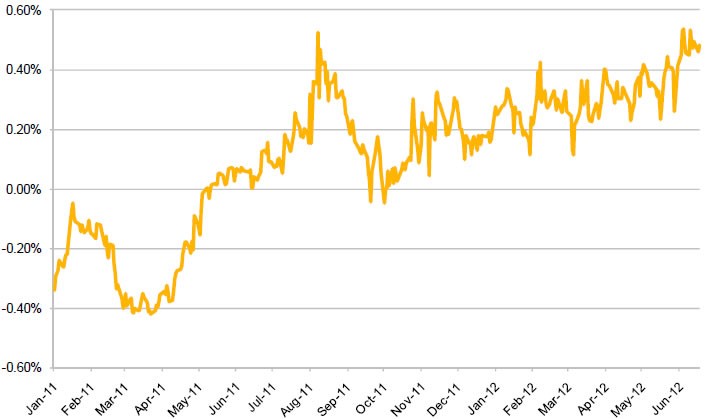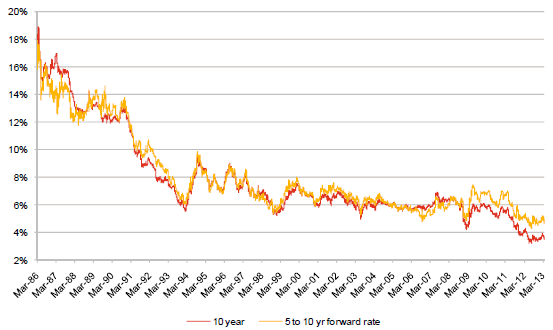5 LongTerm Real RiskFree Discount Rates Methodology for Riskfree Discount Rates and CPI
Post on: 28 Май, 2015 No Comment

5.1 Introduction
5.1.1 This section sets out the Treasury’s view of the ultimate long-term real risk-free rate. Section 6 looks at the ultimate long-term nominal risk-free rate and Section 7 looks at the long-term CPI assumption.
5.1.2 These three long term assumptions are closely connected. The order in which we have discussed them is deliberate.
5.1.3 The long-term real risk-free rate is considered first because this is the primary driver of the value of cash flows that are inflated. In addition it is reasonable to expect the real return to be largely unaffected to changes in long-term inflation outlook.
5.1.4 The nominal risk-free rate is considered second because it is the focus of accounting standards and can be cross checked to historical market rates. Finally, the long-term CPI assumption is derived from the first two assumptions.
5.1.5 The real rate of interest is the amount by which the nominal interest rate is higher than the inflation rate. The real risk-free interest rate is the theoretical rate of return of an investment with zero risk, after taking into account the effects of inflation. The real risk-free rate represents the real return an investor would expect from an absolutely risk-free investment over a given period of time.
5.1.6 The long-term real risk-free rate is a critical assumption in the valuation of the ACC claims liability and GSF pension obligation. Both of these obligations are linked to inflation. The value of these obligations is dependent on the real return (ie, the difference between the discount rate and inflation rate). An increase or decrease in both inflation and discount rates together will not change the value of the liabilities.
5.1.7 There is an absence of any direct and observable long-term yields to proxy a real risk-free rate in New Zealand. Therefore, we will determine a hypothetical real yield curve to match the duration of the Government’s obligations and assets. We believe that determining an ultimate single long-term real yield is a rational and pragmatic approach to create the long end of the yield curve. This approach is supported by international commentators in the actuarial profession as discussed in section 9 of this paper.
5.1.8 We have concluded in earlier discussions of short-term assumptions that the most appropriate proxy for risk-free rates in New Zealand is the yield on government stock. Therefore, in the long term context, it is consistent that the resulting risk-free rate we assume is cross-checked against available data of real yields on government bonds in New Zealand.
5.2 Summary
5.2.1 The methodology is that a single long-term real risk-free rate can be set for accounting valuations and this rate should be stable for a reasonable time period.
5.2.2 In the absence of any long-term market data in New Zealand we have applied judgment in selecting the rate. Recent historical real risk-free returns, returns on long-term New Zealand index-linked bonds (if any), returns on relevant offshore index linked bonds and economic theory are all relevant to selecting the long-term real risk-free discount rate.
5.2.3 Recent historical rates, market observations and economic theory all point to a long-term real return currently of between 3.0% pa and 4.0% pa in New Zealand. In our view there is no compelling argument to go to either end of the range to set the rate. Consequently we have set the long-term real return assumption at 3.5% pa, being the mid-point of the range. We recognize that this is a judgment but have been guided by our analysis that 3.5% pa falls within the range of most of the indicators discussed below. In summary the 3.5% is supported by historical analysis, limited index bond data and economic theory.
5.3 Analysis
5.3.1 The analysis of the long-term real rate of return is summarised beneath the following three headings; historical rates, indexed linked stock and economic theory.
5.4 Historical Rates
5.4.1 In reviewing the historical real risk-free rate we have looked at the difference between interest rates and inflation rates in the past. There are a number of ways of considering this. The first is to look at 1 year interest rates compared to inflation expectations for the following year. Data on inflation expectations is not readily available, so instead we have performed this analysis retrospectively using actual inflation data compared to 1 year interest rates as at the start of that year. Because of this lag the graph only goes to March 2009. We recommend that in future this analysis be done using inflation forecast data if possible.
5.4.2 The following chart shows the historical difference between 1 year forward rates for New Zealand government stock and actual inflation for that year, as measured by CPI.
1 year stock (forward rate) less inflation (next year)
5.4.3 The graph shows that interest rates on 1 year government stock have been between 3% pa and 4% pa higher than CPI inflation for the last 8 years. In the last year, however, the observed gap has narrowed significantly, due to the dramatic drop in short-term interest rates.
5.4.4 This comparison of 1 year rates is affected significantly by monetary policy either tightening or loosening and does not allow for the difference between 1 year yields and long-term yields.
5.4.5 It is more relevant to look at the difference between long-term rates and inflation. The following graph shows the difference between 10 year forward rates on New Zealand government stock at the start of the year and inflation experienced over the year.
10 year stock less inflation
5.4.6 The 3 year average has been between 3% pa and 4% pa for the last 7 years, indicating that the difference between 10 year stock and CPI has consistently been in the range of 3% to 4% for the last 10 years.
5.4.7 Further analysis could be done to the longest duration of inflation forecasts and a matching interest rate, for example average 5 year inflation forecasts and 5 year government stock. This comparison would not be as affected by short term monetary policy. We have not done this analysis in detail, but 5 year inflation forecasts have been around 2.5% for a number of years and 5 year government stock has been around 6% over the last 8 to 10 years. This results in a similar conclusion.
5.5 Index Linked Stock
New Zealand index linked stock
5.5.1 Inflation linked bonds can be useful evidence of the markets view of real rates of return. In New Zealand there is only one index linked stock on issue, maturing in 2016. The history of this is shown in the graph below. Note that duration of this stock has become progressively shorter, from 20 years in 1995 to 6 years now.
Real and Nominal Government Bond Yield History

5.5.2 For the last eight years this stock has been trading to yield between 3% pa and 4% pa. In the last year, the drop in yield has been driven mainly by the drop in short-term interest rates now that the duration of this stock is getting much shorter. In future this stock will not give much guidance to real yields in the longer term. In addition, any extrapolation of CPI inflation expectation from this stock is made complex by the mix of taxed and non-taxed investors who trade in it. Both the tax effect and an excess of demand over supply put downward pressure on the yields of this stock.
5.5.3 New issues of longer dated indexed stock, particularly longer than ten years, will provide additional information on longer term real yields. If such issues were to become available then how this information is incorporated will largely be a matter of judgement. Factors to be considered will be the duration of the stock, supply and demand pressures as well as market factors for nominal stock.
US index linked stock
5.5.4 The US Treasury quotes a 30 year index linked bond price. The return on this bond is 1.85% pa currently, and since 2004 has ranged between 1.8% pa and 2.5% pa.
5.5.5 This can be put into a New Zealand context by adding a risk premium to reflect the extra risk of investing in New Zealand. The Treasury’s assessment of this country risk premium, as discussed below, is 1% pa.
5.5.6 This suggests a real return on a hypothetical 30 year inflation linked New Zealand government stock of approximately 3% pa currently or a range between 2.8% pa and 3.5% pa, since 2004.
5.6 Economic Theory
Link to GDP growth
5.6.1 The Treasury paper Discount Rates for the Calculation of the Retirement Plan Liability of the Crown for the Government Superannuation Fund, dated 28 August 2009 summarises the theoretical link between real interest rates and GDP growth. The paper was written specifically to support the discount rate assumptions for the GSF pension valuations for the Government’s 2009 financial statements.
5.6.2 The Treasury considered the elements that comprise interest rates and relevant historical experience in the 2009 paper. Interest rates can be broken down into different components. The exact allocation between these components is not precise and may vary over time.
- The real component represents the real return on capital which should equate to long-term real economic growth rates. As this is from a global perspective, it is world growth that is relevant. Economic forecasters in Treasury have assumed this to be 3% per annum. New Zealand’s real growth has averaged just above 3% over the past 10 years.
- The second component of an interest rate is compensation for inflation; Treasury economic forecasters currently assume that New Zealand’s inflation will average 2% per annum in the long-term, the mid-point of the RBNZ’s target band.
- The third component of interest rates in a world of global capital markets is a country risk premium. This reflects the premium demanded by foreigners to invest in New Zealand. The reasons commonly given for it are the large current account deficit (8.5% of GDP in the year to March 2009) and associated net debt position (98% of GDP at 31 March 2009), the small size of the economy (leading to a liquidity premium for NZ bonds), its dependence on primary product exports (which are subject to large swings in demand and can be affected by factors such as climate), the relatively short history of inflation targeting (although this history is now becoming longer) and levels of government debt (low over the past decade).
5.6.3 The economic theory is that in the long-term, interest rates are composed of three components:
- inflation
- real return on capital which should equate to long term real economic growth rates, and
- a country risk premium.
5.6.4 The rates adopted by the Treasury in the 2009 paper in support of a long-term bond rate are summarised below:
Components of long-term interest rates














